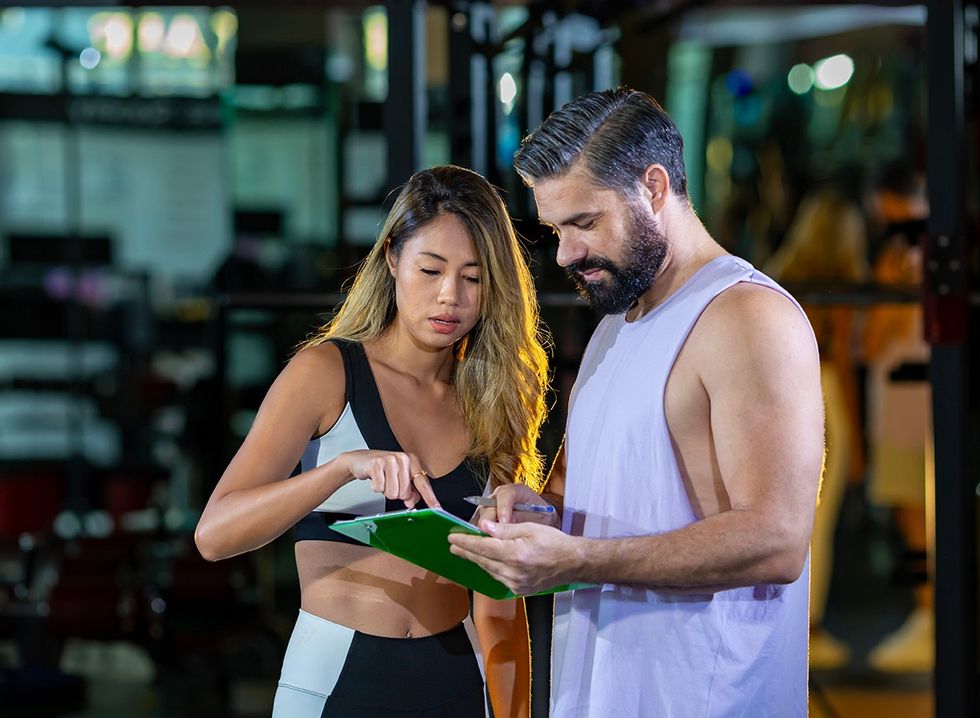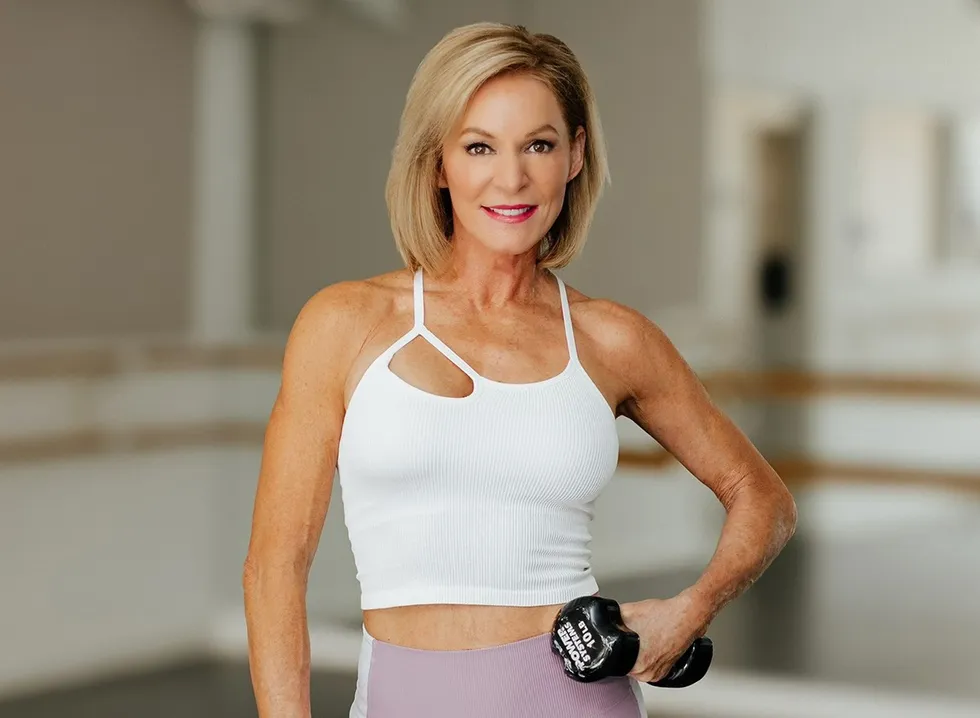As 15x Ironman, I know a thing or two about strength training, and now want to share it with you. First, a bit about my journey, so you know who I am and what I can do: I received my education in a Master's Degree in Science with an emphasis in Exercise Science from the Univesity of Texas in San Antonio. Before receiving my Master's Degree, I participated in 4 Ironman Triathlons, a 2.4-mile swim, a 112-mile bike, and a 26.2-mile run, but I wanted to learn more about the "why" and the "how" through knowledge. While getting my Master's Degree, I didn't have the time to train for an Ironman Triathlon. I found CrossFit, participated in it, and coached it with a Level I Certification. CrossFit kept me sane while I was getting my degree at 40 years old. I needed to move, but I needed something quick and to the point. CrossFit did that for me.
During CrossFit, I learned so much about form, strength, and movement that I could take this knowledge to the clients I worked with then and now. After graduating, I returned as an athlete and accomplished 11 more Ironman Triathlons, including achieving my 28-year-old dream, the Ironman World Championship in Hawaii in 2017, while I started my business, JenRulon.com.
Where it gets good is learning about my knowledge of strength during my Ironman Triathlon training and beyond, as so many triathletes will push the strength training aside. My goal with my triathletes and runners is to keep the muscle on as long as possible before heading into the heavy specific training for a race.
As I have retired from the sport of triathlon as an athlete, I now focus on my strength training, surfing, walking, and riding the beach cruiser around my town in Costa Rica. I have never felt more confident, muscular, and fit heading into the second part of my life as a 52-year-old woman. And now, I get to share this with others on their journey of change. Here are 7 proven strength training exercises to get you fit.
1. Why Strength Training is Key to a Strong Body

Did you know that after 30, we will start losing our muscle mass by 3 - 8% per decade? But after 60 years old, the rate of muscle mass decreases at a higher rate.
Strength exercises are crucial for health for several reasons:
- We want to improve our muscle strength and tone to protect our joints from injury.
- We need to maintain balance and flexibility, especially as we age because we want to do what we should be able to do. For example, get on the floor with our grandkids or push ourselves off the floor from playing with the grandkids.
- Strength training will improve weight management; as you gain more muscle, your body will burn more calories at rest.
2. Here's How to Get Ready for Strength Training

Like the start of any exercise, ensure you get approval from a doctor or health care professional. Make sure you are comfortable with the equipment in the gym. If you are not, hire a coach or a personal trainer who can guide you to the equipment and help you make sure you have the proper form. If you are new, you want to avoid putting heavy weight on a poor form. Speaking of which, make sure you go lighter when you are starting. If you did weights in high school, understood the body mechanics, and could do a PR deadlift, good for you, but that was 20 years ago. Many clients will start too heavy too soon and then have problems sitting on the toilet or a chair or picking up their child and not want to work out again. My last thought is to add variety to your strength exercises. There are many forms of squats, which we will discuss below, and there are many pieces of equipment, from dumbbells, kettlebells, barbells, machines, weighted medicine balls, bands, and even your body weight.
Related: 10 Training Tips I Wish I Knew Earlier, by an Expert Fitness Coach
3. Squats are the First Strength Training Exercise I Recommend

One of my favorites, and many other coaches and personal trainers, are squats. And it is not just bodyweight squats; there are so many options for squats: back squats with a barbell, front squats with a barbell, kettlebell squats, dumbbell squats, overhead squats, sissy squats, box squats, and curtsy squats, to name a few. Want me to keep going? You get my point.
Let me explain how to do a bodyweight squat or an air squat, as working on your form is essential to your success.
- Make sure your feet are shoulder-width apart, your head is in a neutral position, and your eyes look forward.
- As you descend into a squat, ensure your shoulders, hips, toes, and knees are aligned.
- When you "sit back," like sitting in a chair, your body weight will shift into your heels.
- Keep the chest and upper body neutral or with a slight arch.
- Ideally, we want your quadriceps parallel to the ground, but do what is best for you now.
Now, let's talk about why squats. When doing squats, you will be focusing on the lower body muscles such as the gluteus maximus, minimus, medius (aka butt), quadriceps, hamstrings, adductors, hip flexors, and calves. There are many significant benefits that squats can do for you:
- Squats will give you strong glutes, which can help with cardiovascular activities such as walking, running, cycling, hiking, and surfing but are helpful for everyday life. See #2.
- Squats are also suitable for everyday life, such as pushing a stroller, picking yourself off the ground, or getting out of the car, especially as we age.
- Squats can help you strengthen your bones, which can help lower your risk of osteoporosis.
4. Romanian Deadlifts

The "RDL" is working the posterior chain, such as your hamstrings, lower back, and glutes. In the RDL deadlift exercise vs. a deadlift from the ground, you will start with weight (bar, kettlebell, or dumbbells) standing straight up, and then you will lower the weight while hinging at the hip.
Related: I Lost 130 Pounds With Help From Indoor Cycling and Here's How You Can, Too
5. Push-ups

The muscles used for push-ups are chest, shoulders, triceps, biceps, upper and lower back. Push-ups are a great overall body movement for all types of tasks to do in everyday life. Push-ups can be done anywhere on the floor, on a bench, on a wall, or on a stability ball if you are that talented!
6. Shoulder to Overhead Movement

The muscles used for a strict or military press are the deltoid, tricep, pectorals, and serratus anterior. Strict press is a fantastic exercise for improving your long-term shoulder health, which is good for picking up the kids and grandkids and pushing a lawn mower.
7. Bench Press

The muscles used for a bench press are the pectoral muscles (chest), triceps, and delts (shoulders). You can do bench press with dumbbells or a barbell. If you are at home and don't have either, you can utilize canned goods or 1 lb water bottles, and if you don't have a bench, you can always do a floor press.
8. Pull-ups

The muscles are the trapezius (back), deltoids, pectoralis major (chest), triceps, and latissimus dorsi. Pull-ups are hard for many people, and if you can do strict pull-ups, place some weights between your feet or knees and start slow. If you can not do a strict pull-up, do a negative pull-up with your grip pronated (hand on top of the bar), chin over the bar, and slowly lower yourself for at least 10 - 20 seconds.
9. Dumbbell Rows

The muscles used for dumbbell rows are the trapezius, rhomboids, latissimus dorsi, deltoid (posterior), and bicep brachialis. When doing the dumbbell rows, you want to ensure that you pull with the scapula and use your whole body. Dumbbell Rows are a beneficial movement to strengthen the back.
10. Bonus! Core Work!

Working on your abs/core is tricky because sit-ups are only for some. For example, an athlete with back issues may be unable to do sit-ups, so a different type of ab workout needs to be given to them. There are many exercises out there for the core, such as sit-ups, front planks, side planks, dead bugs, bicycle crunch, V-Ups, mountain climbers, and hollow holds, to name a few.
Related: I’ve Tried Nearly Every Diet and This is the #1 Best for Weight Loss For Me
11. Common Mistakes to Avoid

We addressed some mistakes that people should avoid when starting strength training, but here are a couple of mistakes that people should avoid for long-term growth in and out of the gym.
- Increasing your weights too fast: Many people may go into the gym and "remember" the time they had a PR squat or deadlift, which may have been in high school and will try to start with that mentality immediately. Slow down, friends! As a coach or a trainer, we want to improve your strength gradually. You don't lose your strength overnight or gain it overnight.
- Time To Recover: Rest is vital, whether having a day off during the week or taking time off between upper and lower body days. Make sure you schedule a day off during the week. Contact a coach or personal trainer if you are still determining when to take it off.
- Improper Technique: Proper form can make or break you during strength training. It may look different if you have poor form and try adding weights to it. Make sure you work with someone who knows how to teach the form or watch videos that can show you how to do the form correctly. If you have a friend who can film you, you can also give yourself feedback or show your coach or personal trainer.
- Overtraining: Many do this. Many fail. When an athlete, runner, or fitness enthusiast doesn't recover after tough sessions, this can lead to injury, sickness, poor performance, and fatigue.
12. Final Word From the Expert

I can't emphasize the importance of strength training for the everyday human, athlete, Mom, Dad, and Grandparents. Yes, I was the triathlete who avoided it because I didn't have "time" for it. Looking back, I wish I had understood the importance of it, not just for the triathlon space but for the longevity of living. In the last couple of years, society is understanding the importance of strength training. Women genuinely understand the importance of strength training, especially those going into "the change" of perimenopausal and menopause. And no, women will not get bulky for strength training, especially if you have a nice blend of cardiovascular work such as skiing, walking, running, swimming, cycling, or surfing and strength training. The body will "balance" it with good nutrition and mindset.
💪🔥Body Booster: Make sure you go lighter when you are starting. Many people will start too heavy too soon and then have problems sitting on the toilet or a chair or picking up their child and not want to work out again.
Jen Rulon's transformation from a 15x Ironman triathlete to an everyday healthy human unfolded through a blend of strength training, walks, healthy eating, meditation, surfing, journaling, setting boundaries, and embracing life in Costa Rica, embodying her passion for fitness and authentic living.
















 Jeff Nippard/YouTube
Jeff Nippard/YouTube Jeff Nippard/YouTube
Jeff Nippard/YouTube Jeff Nippard/YouTube
Jeff Nippard/YouTube Jeff Nippard/YouTube
Jeff Nippard/YouTube Jeff Nippard/YouTube
Jeff Nippard/YouTube
 Liz Hilliard
Liz Hilliard





 Liz Hilliard
Liz Hilliard Liz Hilliard
Liz Hilliard Liz Hilliard
Liz Hilliard
 Shutterstock
Shutterstock Shutterstock
Shutterstock Shutterstock
Shutterstock Shutterstock
Shutterstock Shutterstock
Shutterstock Shutterstock
Shutterstock Shutterstock
Shutterstock Shutterstock
Shutterstock Shutterstock
Shutterstock

 I'm a Nutritionist and These 9 High-Protein Snacks Keep My Clients Full While Losing 50 Pounds
I'm a Nutritionist and These 9 High-Protein Snacks Keep My Clients Full While Losing 50 Pounds
 Shutterstock
Shutterstock 2. Processed FoodsShutterstock
2. Processed FoodsShutterstock Shutterstock
Shutterstock Shutterstock/Prostock-studio
Shutterstock/Prostock-studio Shutterstock
Shutterstock Pro TipsShutterstock
Pro TipsShutterstock Shutterstock
Shutterstock Shutterstock
Shutterstock Shutterstock
Shutterstock Shutterstock
Shutterstock Don’t Drink as Much AlcoholShutterstock
Don’t Drink as Much AlcoholShutterstock Most Women on GLP-1s Are Making a Few Common MistakesShutterstock
Most Women on GLP-1s Are Making a Few Common MistakesShutterstock Soda and Sugary DrinksShutterstock
Soda and Sugary DrinksShutterstock Shutterstock
Shutterstock Eat BreakfastShutterstock
Eat BreakfastShutterstock And Improve Insulin SensitivityShutterstock
And Improve Insulin SensitivityShutterstock Belly Flab Strip Tip: Sugar and Fat Calories Leave Its Mark on Your BodyShutterstock
Belly Flab Strip Tip: Sugar and Fat Calories Leave Its Mark on Your BodyShutterstock Shutterstock
Shutterstock The Drugs Mimic the GLP-1 Hormone Naturally Produced by the BodyShutterstock
The Drugs Mimic the GLP-1 Hormone Naturally Produced by the BodyShutterstock 3. Deep-Fried ItemsShutterstock
3. Deep-Fried ItemsShutterstock